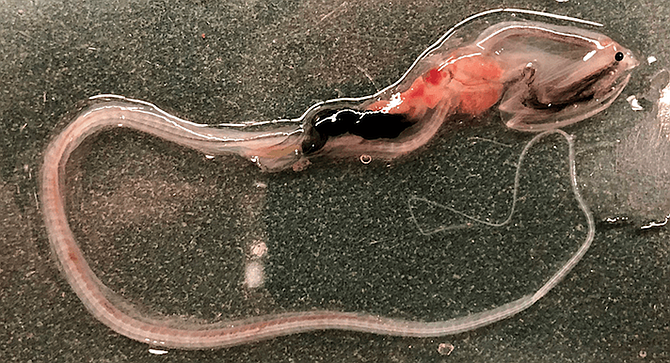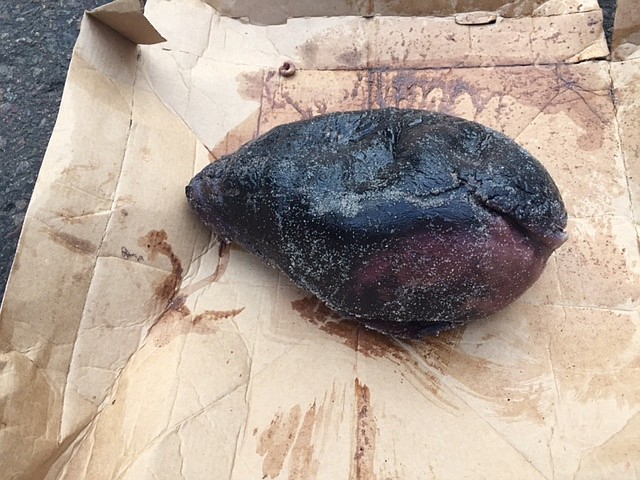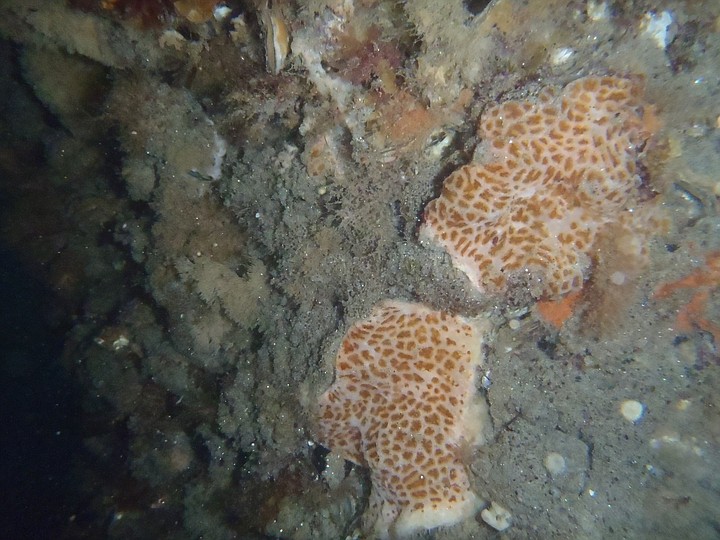 Facebook
Facebook
 X
X
 Instagram
Instagram
 TikTok
TikTok
 Youtube
Youtube

A sea hare, a gulper eel, and a colony of what looks like sea pork have all turned up recently on the San Diego coast, keeping local scientists busy.

In early October, a beachgoer at Windansea in La Jolla found a shiny dark brown animal, like a squishy rock, that he could not identify. He photographed it and brought it to the attention of researchers at Scripps Institution of Oceanography, who circulated the photo via email. Kay Isabelle recognized it as a California Black Sea Hare, aplysia vaccaria. Recent extreme low tides have increased sightings of the organism in Southern California tide pools. Its population, low during the past decade, seems to be rebounding due to algal blooms that provide food. Sea hares can grow to up to two feet and weigh 20 pounds.

Late in October, UC San Diego marine biology students on a research cruise unexpectedly encountered a deep-sea dweller: a gulper eel. The eel came up with a haul from 500-700 meters below the surface, about 10 miles out to sea on the west side of the Coronado Escarpment. The translucent, eight-inch juvenile was fully intact, down to the light organ on its tail.
"It's a very rare fish and they're usually found a lot deeper, below 1000 or 1500 meters," said Ben Frable, director of the Marine Vertebrate Collection at Scripps.
It is only the 11th of its species in the collection. The black blob inside the gulper eel’s translucent body is the animal’s gut, which is opaque to block the bioluminescent prey the eels eat from attracting other predators. Ph.D. student Dan Conley identified the unusual find.
Sea pork is a common name for aplidium stellatum, a tunicate usually found in waters from Maine to the Gulf of Mexico. Graduate researcher Chris Leber thinks it might be thriving on the pilings of Scripps pier, though previously undocumented in California. Leber and his advisor spotted the orange, spotty organisms on a training dive. The scientitsts noticed that where the tunicate colonies were growing, other animals were not—unusual for a pier piling, “where things are typically growing over each other.” This type of isolation in a marine environment might indicate toxic chemistry.


A sea hare, a gulper eel, and a colony of what looks like sea pork have all turned up recently on the San Diego coast, keeping local scientists busy.

In early October, a beachgoer at Windansea in La Jolla found a shiny dark brown animal, like a squishy rock, that he could not identify. He photographed it and brought it to the attention of researchers at Scripps Institution of Oceanography, who circulated the photo via email. Kay Isabelle recognized it as a California Black Sea Hare, aplysia vaccaria. Recent extreme low tides have increased sightings of the organism in Southern California tide pools. Its population, low during the past decade, seems to be rebounding due to algal blooms that provide food. Sea hares can grow to up to two feet and weigh 20 pounds.

Late in October, UC San Diego marine biology students on a research cruise unexpectedly encountered a deep-sea dweller: a gulper eel. The eel came up with a haul from 500-700 meters below the surface, about 10 miles out to sea on the west side of the Coronado Escarpment. The translucent, eight-inch juvenile was fully intact, down to the light organ on its tail.
"It's a very rare fish and they're usually found a lot deeper, below 1000 or 1500 meters," said Ben Frable, director of the Marine Vertebrate Collection at Scripps.
It is only the 11th of its species in the collection. The black blob inside the gulper eel’s translucent body is the animal’s gut, which is opaque to block the bioluminescent prey the eels eat from attracting other predators. Ph.D. student Dan Conley identified the unusual find.
Sea pork is a common name for aplidium stellatum, a tunicate usually found in waters from Maine to the Gulf of Mexico. Graduate researcher Chris Leber thinks it might be thriving on the pilings of Scripps pier, though previously undocumented in California. Leber and his advisor spotted the orange, spotty organisms on a training dive. The scientitsts noticed that where the tunicate colonies were growing, other animals were not—unusual for a pier piling, “where things are typically growing over each other.” This type of isolation in a marine environment might indicate toxic chemistry.
Comments